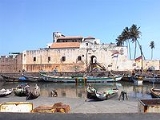
Elmina Castle
Encyclopedia
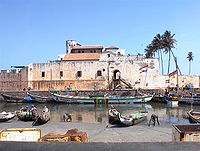
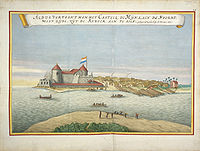
Portugal
Portugal , officially the Portuguese Republic is a country situated in southwestern Europe on the Iberian Peninsula. Portugal is the westernmost country of Europe, and is bordered by the Atlantic Ocean to the West and South and by Spain to the North and East. The Atlantic archipelagos of the...
in 1482 as São Jorge da Mina (St. George of the Mine) Castle, also known simply as Mina or Feitoria
Factory (trading post)
Factory was the English term for the trading posts system originally established by Europeans in foreign territories, first within different states of medieval Europe, and later in their colonial possessions...
da Mina) in present-day Elmina
Elmina
Elmina, is a town in the Central Region, situated on a south-facing bay on the Atlantic Ocean coast of Ghana, about 12 km west of Cape Coast...
, Ghana
Ghana
Ghana , officially the Republic of Ghana, is a country located in West Africa. It is bordered by Côte d'Ivoire to the west, Burkina Faso to the north, Togo to the east, and the Gulf of Guinea to the south...
(formerly the Gold Coast
Gold Coast (British colony)
The Gold Coast was a British colony on the Gulf of Guinea in west Africa that became the independent nation of Ghana in 1957.-Overview:The first Europeans to arrive at the coast were the Portuguese in 1471. They encountered a variety of African kingdoms, some of which controlled substantial...
). It was the first trading post built on the Gulf of Guinea
Gulf of Guinea
The Gulf of Guinea is the northeasternmost part of the tropical Atlantic Ocean between Cape Lopez in Gabon, north and west to Cape Palmas in Liberia. The intersection of the Equator and Prime Meridian is in the gulf....
, so is the oldest European building in existence below the Sahara
Sahara
The Sahara is the world's second largest desert, after Antarctica. At over , it covers most of Northern Africa, making it almost as large as Europe or the United States. The Sahara stretches from the Red Sea, including parts of the Mediterranean coasts, to the outskirts of the Atlantic Ocean...
. First established as a trade settlement, the castle later became one of the most important stops on the route of the Atlantic slave trade
Atlantic slave trade
The Atlantic slave trade, also known as the trans-atlantic slave trade, refers to the trade in slaves that took place across the Atlantic ocean from the sixteenth through to the nineteenth centuries...
. The Dutch
Netherlands
The Netherlands is a constituent country of the Kingdom of the Netherlands, located mainly in North-West Europe and with several islands in the Caribbean. Mainland Netherlands borders the North Sea to the north and west, Belgium to the south, and Germany to the east, and shares maritime borders...
seized the fort from the Portuguese in 1637, and took over all the Portuguese Gold Coast
Portuguese Gold Coast
The Portuguese Gold Coast was a Portuguese colony on the West African Gold Coast on the Gulf of Guinea.-History:The Portuguese established the following settlements on the Gold Coast from January 21, 1482:...
in 1642. The slave trade continued under the Dutch until 1814; in 1871 the Dutch Gold Coast
Dutch Gold Coast
The Dutch Gold Coast or Dutch Guinea, officially Dutch possessions on the Coast of Guinea was a portion of coastal West Africa that was gradually colonized by the Dutch, beginning in 1598...
, including the fort, became a possession of the British Empire
British Empire
The British Empire comprised the dominions, colonies, protectorates, mandates and other territories ruled or administered by the United Kingdom. It originated with the overseas colonies and trading posts established by England in the late 16th and early 17th centuries. At its height, it was the...
.
Britain granted the Gold Coast its independence in 1957, and control of the castle was transferred to the nation formed out of the colony, present-day Ghana. Today it is a popular historical site, and was a major filming location for Werner Herzog
Werner Herzog
Werner Herzog Stipetić , known as Werner Herzog, is a German film director, producer, screenwriter, actor, and opera director.He is often considered as one of the greatest figures of the New German Cinema, along with Rainer Werner Fassbinder, Margarethe von Trotta, Volker Schlöndorff, Werner...
's Cobra Verde
Cobra Verde
Cobra Verde is a 1987 German drama film based upon Bruce Chatwin's 1980 novel, The Viceroy of Ouidah. The film depicts the life of a fictional slave trader named Francisco Manoel da Silva who is played by the prolific German actor Klaus Kinski...
. The castle is recognized by UNESCO
UNESCO
The United Nations Educational, Scientific and Cultural Organization is a specialized agency of the United Nations...
as a World Heritage Site
World Heritage Site
A UNESCO World Heritage Site is a place that is listed by the UNESCO as of special cultural or physical significance...
.
Pre-Portuguese
The people living along the West AfricaWest Africa
West Africa or Western Africa is the westernmost region of the African continent. Geopolitically, the UN definition of Western Africa includes the following 16 countries and an area of approximately 5 million square km:-Flags of West Africa:...
n coast at Elmina around the fifteenth century were presumably Fante. The Fante ethnicity bears an uncertain relationship to "Akan," itself a word connoting originality from the root word, "kan", to be first or original. Among their ancestors were merchants and miners trading gold into the Mediterranean and Near Eastern worlds from medieval times. The ancestors of the Akan-speakers of the forests however undoubtedly came from north of the forest.
The people on the West African coast were organized into numerous populations that were drawn according to kinship lines. Family was extremely important in society, and family heads were united in communities under a recognized local authority. Along the Gold Coast alone, more than twenty independent kingdom-states existed. Elmina lay between two different Fante kingdoms, Fetu and Eguafo. While there was a relative degree of interstate rivalry, peoples generally intermingled freely. Trade between localities was important for the economy. The coastal people also had strong trade relations with the Sudan
Sudan
Sudan , officially the Republic of the Sudan , is a country in North Africa, sometimes considered part of the Middle East politically. It is bordered by Egypt to the north, the Red Sea to the northeast, Eritrea and Ethiopia to the east, South Sudan to the south, the Central African Republic to the...
ese empires to the north.
West Africans nurtured ancient connections to other parts of the world. Common metals trade, iconic artistic forms, and agricultural borrowing show that trans-Saharn and regional coastal connections thrived. The Portuguese in 1471 were the first Europeans to visit the Gold Coast as such, but not necessarily the first sailors to reach the port.
Portuguese arrival
The Portuguese first reached what became known as the Gold Coast in 1471. Prince Henry the Navigator first sent ships to explore the African coast in 1418. The Portuguese had several motives for voyaging south. They were attracted by rumors of fertile African lands that were rich in goldGold
Gold is a chemical element with the symbol Au and an atomic number of 79. Gold is a dense, soft, shiny, malleable and ductile metal. Pure gold has a bright yellow color and luster traditionally considered attractive, which it maintains without oxidizing in air or water. Chemically, gold is a...
and ivory
Ivory
Ivory is a term for dentine, which constitutes the bulk of the teeth and tusks of animals, when used as a material for art or manufacturing. Ivory has been important since ancient times for making a range of items, from ivory carvings to false teeth, fans, dominoes, joint tubes, piano keys and...
. They also sought a southern route to India
India
India , officially the Republic of India , is a country in South Asia. It is the seventh-largest country by geographical area, the second-most populous country with over 1.2 billion people, and the most populous democracy in the world...
so as to circumvent Arab
Arab
Arab people, also known as Arabs , are a panethnicity primarily living in the Arab world, which is located in Western Asia and North Africa. They are identified as such on one or more of genealogical, linguistic, or cultural grounds, with tribal affiliations, and intra-tribal relationships playing...
traders and establish direct trade with Asia. In line with the strong religious sentiments of the time, another focus of the Portuguese was Christian proselitism
Evangelism
Evangelism refers to the practice of relaying information about a particular set of beliefs to others who do not hold those beliefs. The term is often used in reference to Christianity....
. They also sought to form an alliance with the legendary Prester John
Prester John
The legends of Prester John were popular in Europe from the 12th through the 17th centuries, and told of a Christian patriarch and king said to rule over a Christian nation lost amidst the Muslims and pagans in the Orient. Written accounts of this kingdom are variegated collections of medieval...
, who was believed to be the leader of a great Christian nation somewhere in Africa.
These motives prompted the Portuguese to develop the Guinea trade. They made gradual progress down the African coast, each voyage reaching a point further along than the last. After fifty years of coastal exploration, the Portuguese finally reached Elmina in 1471, during the reign of King Afonso V. However, because Portuguese royalty had lost interest in African exploration as a result of meager returns, the Guinea trade was put under the oversight of the Portuguese trader, Fernão Gomes
Fernão Gomes
Fernão Gomes was a Portuguese merchant and explorer from Lisbon, the son of Tristão Gomes de Brito .In 1469, King Afonso V of Portugal granted him the monopoly on trade in the Gulf of Guinea...
. Upon reaching present day Elmina, Gomes discovered a thriving gold trade already established among the natives and visiting Arab and Berber traders. He established his own trading post, and it became known to the Portuguese as “A Mina” (the Mine) because of the gold that could be found there.
Construction
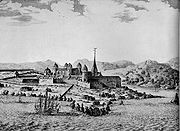
John II of Portugal
John II , the Perfect Prince , was the thirteenth king of Portugal and the Algarves...
decided to build a fort on the coast in order to ensure the protection of this trade, which was once again held as a royal monopoly. King João sent all of the materials needed to build the fort on ten caravels and two transport ships. The supplies, which included everything from heavy foundation stones to roof tiles, were sent, in pre-fitted form, along with provisions for six hundred men. Under the command of Diogo de Azambuja
Diogo de Azambuja
Diogo de Azambuja was a Portuguese noble.He was a knight of the Order of Aviz in the service of the Infante Dom Pedro, son of the Regent Infante Peter, Duke of Coimbra. After Peter's defeat and death in the battle of Alfarrobeira , he accompanied his master into exile...
, the fleet set sail on 11 December 1481 and arrived at Elmina a little over a month later, on 19 January 1482. Some historians note that Christopher Columbus
Christopher Columbus
Christopher Columbus was an explorer, colonizer, and navigator, born in the Republic of Genoa, in northwestern Italy. Under the auspices of the Catholic Monarchs of Spain, he completed four voyages across the Atlantic Ocean that led to general European awareness of the American continents in the...
was among those to make the voyage to the Gold Coast with this fleet.
Upon arrival, Azambuja contracted a Portuguese trader, who had lived at Elmina for some time, to arrange and interpret an official meeting with the local chief, Kwamin Ansah (interpreted from the Portuguese, "Caramansa"). Concealing his self-interest with elegant manners and friendliness, Azambuja told the chief of the great advantages in building a fort, including protection from the very powerful king of Portugal.
Chief Kwamin Ansah, while accepting Azambuja, as he had any other Portuguese trader who arrived on his coast, was wary of a permanent settlement. However, with firm plans already in place, the Portuguese would not be deterred. After offering gifts, making promises, and hinting at the consequences of noncompliance, the Portuguese finally received Kwamin Ansah's reluctant agreement.
When construction began the next morning, the chief’s reluctance was proved to be well-founded. In order to build the fort in the most defensible position on the peninsula, the Portuguese had to demolish the homes of some of the villagers, who consented only after they had been compensated. The Portuguese also tried to quarry a nearby rock that the people of Elmina, who were animists
Animism
Animism refers to the belief that non-human entities are spiritual beings, or at least embody some kind of life-principle....
, believed to be the home of the god of the nearby River Benya. In response to this, the local people forged an attack that resulted in several Portuguese deaths. Finally, an understanding was reached, but continued opposition led the Portuguese to burn the local village in retaliation. Even in this tense atmosphere, the first story of the tower was completed after only twenty days; this was the result of having brought so much prepared-in-advance building material. The remainder of the fort and an accompanying church were completed soon afterward, despite resistance.
Immediate impact
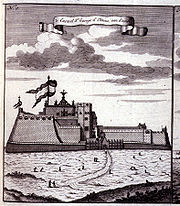
Sub-Saharan Africa
Sub-Saharan Africa as a geographical term refers to the area of the African continent which lies south of the Sahara. A political definition of Sub-Saharan Africa, instead, covers all African countries which are fully or partially located south of the Sahara...
. Upon its completion, Elmina was established as a proper city. Azambuja was named governor, and King João added the title "Lord of Guinea" to his noble titles. São Jorge da Mina took on the military and economic importance that had previously been held by the Portuguese factory at Arguim Island on the southern edge of the Moorish world. At the height of the gold trade in the early sixteenth century, 24,000 ounces of gold
Gold
Gold is a chemical element with the symbol Au and an atomic number of 79. Gold is a dense, soft, shiny, malleable and ductile metal. Pure gold has a bright yellow color and luster traditionally considered attractive, which it maintains without oxidizing in air or water. Chemically, gold is a...
were exported annually from the Gold Coast, accounting for one-tenth of the world’s supply.
The new fort, signifying the permanent involvement of Europeans in West Africa, had a considerable effect on Africans living on the coast. At the urging of the Portuguese, Elmina declared itself an independent state whose Governor then took control of the town’s affairs. The people of Elmina were offered Portuguese protection against attacks from neighboring coastal tribes, with whom the Portuguese had much less genial relations (even though they were friendly with the powerful trading nations in the African interior.) If any tribe attempted to trade with a nation other than Portugal, the Portuguese reacted with aggressive force, often by forming alliances with the betraying nation’s enemies. Hostility between tribes increased, and the traditional organization of tribal societies suffered, especially after the Portuguese introduced them to fire-arms, which made the dominance of the stronger tribes easier.
Trade with the Europeans helped make certain goods, such as cloth and beads, more available to the coastal people, but European involvement also disrupted traditional trade routes between coastal people and northern tribes by cutting out the African middlemen. The population of Elmina swelled with traders from other towns hoping to trade with the Portuguese, who gradually established a west-African monopoly.
Atlantic slave trade
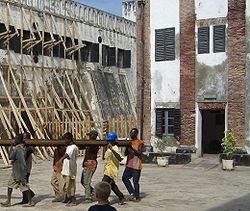
West Africa
West Africa or Western Africa is the westernmost region of the African continent. Geopolitically, the UN definition of Western Africa includes the following 16 countries and an area of approximately 5 million square km:-Flags of West Africa:...
concentrated on the sale of slaves. São Jorge da Mina played a significant part in the Atlantic Slave Trade
Atlantic slave trade
The Atlantic slave trade, also known as the trans-atlantic slave trade, refers to the trade in slaves that took place across the Atlantic ocean from the sixteenth through to the nineteenth centuries...
. The castle acted as a depot where slaves were bought in bartering fashion from local African chiefs and kings. The slaves, often captured in the African interior by the slave-catchers of coastal tribes, were sold to Portuguese traders in exchange for goods such as textiles and horses. The slaves were held captive in the castle before exiting through the castle’s infamous “Door of No Return” to be transported and resold in newly colonized Brazil
Brazil
Brazil , officially the Federative Republic of Brazil , is the largest country in South America. It is the world's fifth largest country, both by geographical area and by population with over 192 million people...
and other Portuguese colonies.
Control by other European nations
In 1637 the fort was taken over by the DutchNetherlands
The Netherlands is a constituent country of the Kingdom of the Netherlands, located mainly in North-West Europe and with several islands in the Caribbean. Mainland Netherlands borders the North Sea to the north and west, Belgium to the south, and Germany to the east, and shares maritime borders...
, who made it the capital of the Dutch Gold Coast
Dutch Gold Coast
The Dutch Gold Coast or Dutch Guinea, officially Dutch possessions on the Coast of Guinea was a portion of coastal West Africa that was gradually colonized by the Dutch, beginning in 1598...
. During the period of Dutch control, they built a new, smaller fortress on a nearby hill to protect St. George Castle from inland attacks. This fort was called Koenraadsburg. The Dutch continued the triangular Atlantic slave route until 1814, when the Dutch slave trade was abolished, pursuant to the Anglo-Dutch Treaty of 1814
Anglo-Dutch Treaty of 1814
The Anglo-Dutch Treaty of 1814 was a treaty signed between Great Britain and the Netherlands in London on August 13, 1814...
. In 1871 the Dutch territory was taken over by the British
British Empire
The British Empire comprised the dominions, colonies, protectorates, mandates and other territories ruled or administered by the United Kingdom. It originated with the overseas colonies and trading posts established by England in the late 16th and early 17th centuries. At its height, it was the...
in the context of the Anglo-Dutch Sumatra treaties of that year.
Renovation
The castle was extensively restored by the Ghanaian government in the 1990s. Renovation of the castle continues. [citation requested]The bridge leading into the castle is one of the highest priority tasks in the project. As of August 2006, the bridge renovation has been completed and construction on the upper terraces continues.

